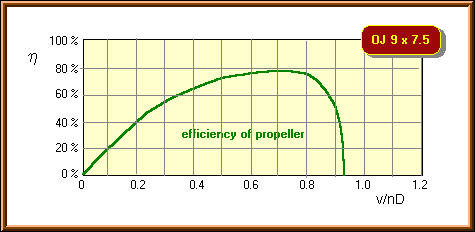A propeller creates a thrust force out of the supplied power. The magnitude of this force is not constant for a given propeller, but depends on the velocity of the incoming air and the rotational velocity of the propeller itself. Thus tests of propellers usually cover a wide regime of operating conditions.
Propellers having the same shape, but scaled by a size factor behave similar. In order to make a comparison of propellers of different size easier, aerodynamicists try to get rid of the units. Then it is possible to use the results of a small scale wind tunnel model to predict the performance of a full scale propeller. Similar to airfoils and wings, the performance of propellers can be described by dimensionless (normalized) coefficients. While an airfoil can be characterized by relations between angle of attack, lift coefficient and drag coefficient, a propeller can be described in terms of advance ratio, thrust coefficient, and power coefficient. The efficiency, which corresponds to the L/D ratio of a wing, can be calculated from these three coefficients. These coefficients are helpful for the comparison of propellers of differing diameters, tested under different operating conditions.
Depending on the country where you live, there may be different coefficients in use. All coefficients used here, are based on the publications of the NACA, which defined the following coefficients:
|
where
|
It should be noted, that the definition of the efficiency includes the velocity v. Thus the efficiency goes to zero when the flight speed approaches zero - of course, this does not mean, that the thrust goes to zero (see also: static thrust of propellers). Usually the power and thrust coefficients are plotted versus the advance ratio. The efficiency of a pylon racing model propeller, as calculated from these coefficients, is show below.

A typical plot of efficiency versus advance ratio v/nD of a propeller for model
airplanes.
Where do you want to go now?
![]() Propulsion by Propellers
Propulsion by Propellers ![]() Design a Prop
Design a Prop ![]() Optimum Propellers
Optimum Propellers
This page has been updated on November, 9th, 1996.
Last modification of this page: 21.05.18
![]()
[Back to Home Page] Suggestions? Corrections? Remarks? e-mail: Martin Hepperle.
Due to the increasing amount of SPAM mail, I have to change this e-Mail address regularly. You will always find the latest version in the footer of all my pages.
It might take some time until you receive an answer
and in some cases you may even receive no answer at all. I apologize for this, but
my spare time is limited. If you have not lost patience, you might want to send
me a copy of your e-mail after a month or so.
This is a privately owned, non-profit page of purely educational purpose.
Any statements may be incorrect and unsuitable for practical usage. I cannot take
any responsibility for actions you perform based on data, assumptions, calculations
etc. taken from this web page.
© 1996-2018 Martin Hepperle
You may use the data given in this document for your personal use. If you use this
document for a publication, you have to cite the source. A publication of a recompilation
of the given material is not allowed, if the resulting product is sold for more
than the production costs.
This document may accidentally refer to trade names and trademarks, which are owned by national or international companies, but which are unknown by me. Their rights are fully recognized and these companies are kindly asked to inform me if they do not wish their names to be used at all or to be used in a different way.
This document is part of a frame set and can be found by navigating from the entry point at the Web site http://www.MH-AeroTools.de/.